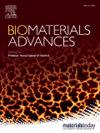An adhesive, antibacterial hydrogel wound dressing fabricated by dopamine-grafted oxidized sodium alginate and methacrylated carboxymethyl chitosan incorporated with Cu(II) complex
IF 5.5
2区 医学
Q2 MATERIALS SCIENCE, BIOMATERIALS
Materials Science & Engineering C-Materials for Biological Applications
Pub Date : 2025-02-06
DOI:10.1016/j.bioadv.2025.214217
引用次数: 0
Abstract
Effective wound dressings play an important role in preventing infections and promoting wound healing. Most polysaccharide-based hydrogel dressings have the drawbacks of weak tissue adhesion and poor antibacterial properties. Herein, a multifunctional dopamine-grafted oxidized sodium alginate-methacrylated carboxymethyl chitosan/gallic acid‑copper(II) complex (OD-CM/GA-CuIIUV) hydrogel was fabricated through Schiff base bonds and photo-crosslinked polymerization between dopamine-grafted oxidized sodium alginate (OSA-DA) and methacrylated carboxymethyl chitosan (CMC-MA), with the integration of gallic acid‑copper(II) complexes (GA-CuII). The double cross-linked network and mussel-inspired adhesion mechanism endowed the hydrogel with attractive physicochemical properties, including excellent self-healing properties, pH-responsive biodegradability, robust toughness, and a maximum adhesion strength of 15.06 kPa. Moreover, the composite hydrogel exhibited an antibacterial ratio of > 99 % against Escherichia coli and Staphylococcus aureus, as well as good antioxidant activity. The MTT assay showed that the cell viability of the composite hydrogel reached > 85 %. The in vivo full-thickness skin defect healing assays in rats demonstrated that the composite hydrogel remarkably accelerated wound repair by attenuating the inflammatory response and promoting epithelial tissue remodeling. Therefore, this novel multifunctional hydrogel has potential applications in biomedical wound dressing.

求助全文
约1分钟内获得全文
求助全文
来源期刊
CiteScore
17.80
自引率
0.00%
发文量
501
审稿时长
27 days
期刊介绍:
Biomaterials Advances, previously known as Materials Science and Engineering: C-Materials for Biological Applications (P-ISSN: 0928-4931, E-ISSN: 1873-0191). Includes topics at the interface of the biomedical sciences and materials engineering. These topics include:
• Bioinspired and biomimetic materials for medical applications
• Materials of biological origin for medical applications
• Materials for "active" medical applications
• Self-assembling and self-healing materials for medical applications
• "Smart" (i.e., stimulus-response) materials for medical applications
• Ceramic, metallic, polymeric, and composite materials for medical applications
• Materials for in vivo sensing
• Materials for in vivo imaging
• Materials for delivery of pharmacologic agents and vaccines
• Novel approaches for characterizing and modeling materials for medical applications
Manuscripts on biological topics without a materials science component, or manuscripts on materials science without biological applications, will not be considered for publication in Materials Science and Engineering C. New submissions are first assessed for language, scope and originality (plagiarism check) and can be desk rejected before review if they need English language improvements, are out of scope or present excessive duplication with published sources.
Biomaterials Advances sits within Elsevier''s biomaterials science portfolio alongside Biomaterials, Materials Today Bio and Biomaterials and Biosystems. As part of the broader Materials Today family, Biomaterials Advances offers authors rigorous peer review, rapid decisions, and high visibility. We look forward to receiving your submissions!

 求助内容:
求助内容: 应助结果提醒方式:
应助结果提醒方式:


